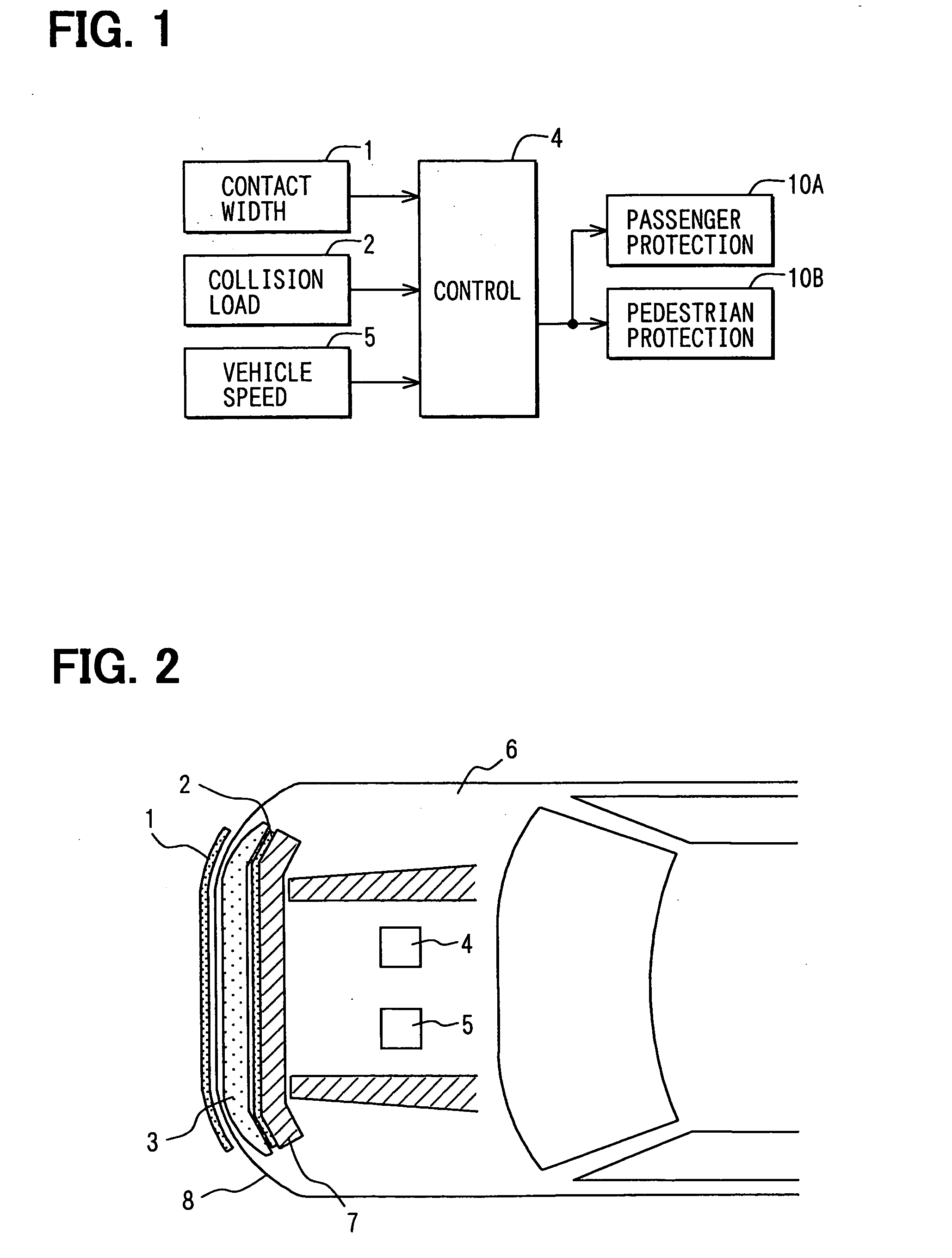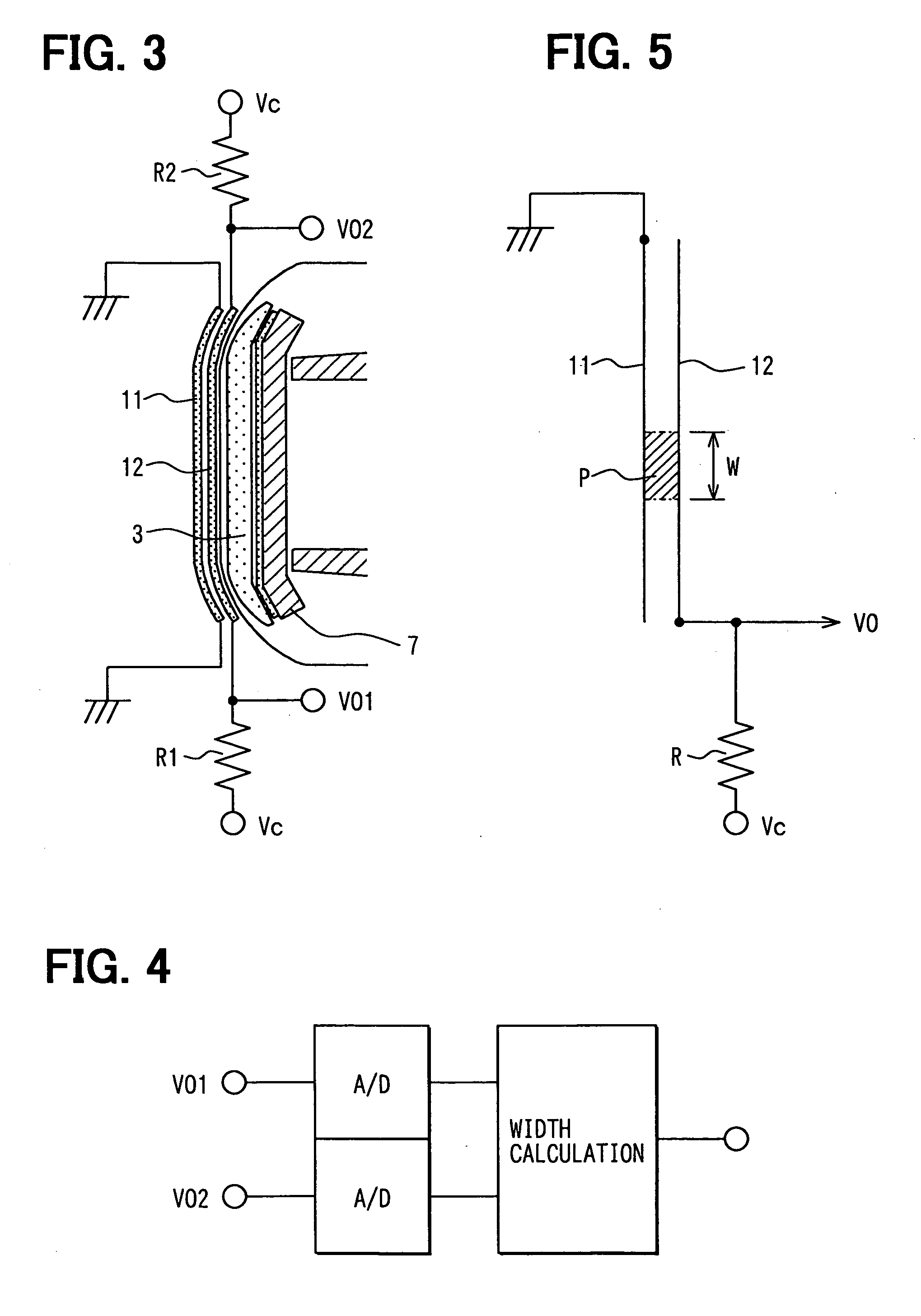Collision object discrimination apparatus for vehicles
- Summary
- Abstract
- Description
- Claims
- Application Information
AI Technical Summary
Benefits of technology
Problems solved by technology
Method used
Image
Examples
first embodiment
[0067] [First Embodiment]
[0068] Referring first to FIG. 1, a collision object determination apparatus according to a first embodiment is comprised a contact width detection sensor 1, a collision load detection sensor 2, an electronic control unit 4 and a vehicle speed sensor 5. The control unit 4 outputs information relating to collision to a passenger protection apparatus 10A and a pedestrian protection apparatus 10B. This information includes information as to whether or not a collision object is a pedestrian.
[0069] The contact width detection sensor 1 is provided as a first collision detection sensor and extends in the lateral direction at the front surface of a bumper cover 8 surrounding a bumper (absorber) 3. The collision load detection sensor 2 is provided as a second collision detection sensor and extends in the lateral direction at the rear surface of the bumper 3. The bumper 3 is provided to extend in the lateral direction at the front surface of a bumper reinforcing memb...
first modification
[0093] (First Modification)
[0094] A modification of a pedestrian discrimination will be described with reference to a flowchart shown in FIG. 10.
[0095] In FIG. 10, the processing till step S21 is the same as that of FIG. 9. In this modification, even in the case where the collision object collision rigidity Kc is within the range where the collision object can be regarded as a pedestrian, it is not immediately determined to be a pedestrian. An additional pedestrian discrimination routine is further carried out to improve a pedestrian discrimination accuracy.
[0096] First, it is determined (S24) whether or not the collision width W falls within a predetermined range of Wth1 to Wthh as a possible range of a pedestrian lateral width. If the collision width does not fall in the predetermined range, the collision object is determined to be other than a pedestrian (S25). If it falls in the predetermined range, a built-in timer T2 is reset (S26) and the collision load F is again read (S27...
second modification
[0101] (Second Modification)
[0102] A further modification of pedestrian discrimination will be described with reference to a flowchart shown in FIG. 11. In this discrimination process, the change of the collision load due to the vehicle speed V is corrected.
[0103] Specifically, after S12, the vehicle speed V is read (S34) from the vehicle speed sensor 5. In order to correct the change of the collision load F changing in accordance with the vehicle speed V, the respective thresholds of FIGS. 9 and 10 are calculated or corrected (S35) by using a stored relation between the vehicle speed V and respective thresholds.
[0104] Besides, when composite collision rigidity K, bumper collision rigidity Kb, and collision object mass M are calculated (S36, S37, S38) on the further basis of the vehicle speed V. For this purpose, each map data may be provided for different vehicle speeds. By doing so, the influence of the vehicle speed on the collision load can be compensated.
PUM
 Login to View More
Login to View More Abstract
Description
Claims
Application Information
 Login to View More
Login to View More - R&D
- Intellectual Property
- Life Sciences
- Materials
- Tech Scout
- Unparalleled Data Quality
- Higher Quality Content
- 60% Fewer Hallucinations
Browse by: Latest US Patents, China's latest patents, Technical Efficacy Thesaurus, Application Domain, Technology Topic, Popular Technical Reports.
© 2025 PatSnap. All rights reserved.Legal|Privacy policy|Modern Slavery Act Transparency Statement|Sitemap|About US| Contact US: help@patsnap.com



